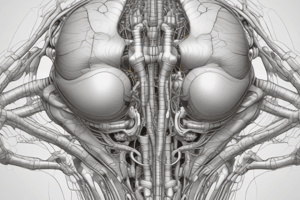Podcast
Questions and Answers
How many degrees of freedom does the elbow joint have?
How many degrees of freedom does the elbow joint have?
- Four, allowing rotation in the coronal plane
- Three, allowing rotation in the transverse plane
- One, allowing flexion and extension in the sagittal plane (correct)
- Two, allowing flexion and extension in the frontal plane
How many major ligaments are directly associated with the elbow joint?
How many major ligaments are directly associated with the elbow joint?
- 3
- 2 (correct)
- 5
- 4
Which type of joint permits rotation for supination and pronation?
Which type of joint permits rotation for supination and pronation?
- Plane joint
- Condyloid joint
- Diarthrodial uniaxial joints of the pivot type (correct)
- Saddle joint
How many muscles are directly associated with the proximal & distal radioulnar joints?
How many muscles are directly associated with the proximal & distal radioulnar joints?
What type of motion occurs at the humeroulnar joint?
What type of motion occurs at the humeroulnar joint?
How many degrees of freedom does the radioulnar joint have?
How many degrees of freedom does the radioulnar joint have?
How many muscles are directly associated with the humeroradial joint?
How many muscles are directly associated with the humeroradial joint?
How many ligaments are associated with the proximal & distal radioulnar joints?
How many ligaments are associated with the proximal & distal radioulnar joints?
What type of joint is the elbow joint considered to be?
What type of joint is the elbow joint considered to be?
What type of motion occurs at the humeroulnar joint?
What type of motion occurs at the humeroulnar joint?
Flashcards
Degrees of Freedom at the Elbow Joint
Degrees of Freedom at the Elbow Joint
The elbow joint allows for movement in only one plane, allowing the arm to bend and straighten.
Major Ligaments of the Elbow
Major Ligaments of the Elbow
Two ligaments directly contribute to the stability and function of the elbow joint.
Type of Joint for Supination and Pronation
Type of Joint for Supination and Pronation
A pivot joint, like the radioulnar joint, allows for rotational movement, enabling the forearm to turn the hand.
Muscles of the Radioulnar Joints
Muscles of the Radioulnar Joints
Signup and view all the flashcards
Motion at the Humeroulnar Joint
Motion at the Humeroulnar Joint
Signup and view all the flashcards
Degrees of Freedom at the Radioulnar Joint
Degrees of Freedom at the Radioulnar Joint
Signup and view all the flashcards
Muscles Attached to the Humeroradial Joint
Muscles Attached to the Humeroradial Joint
Signup and view all the flashcards
Ligaments of the Radioulnar Joints
Ligaments of the Radioulnar Joints
Signup and view all the flashcards
Type of Joint: Elbow
Type of Joint: Elbow
Signup and view all the flashcards
Motion at the Humeroulnar Joint
Motion at the Humeroulnar Joint
Signup and view all the flashcards
Study Notes
Elbow Joint Characteristics
- The elbow joint has 1 degree of freedom.
Ligaments Associated with the Elbow Joint
- There are 3 major ligaments directly associated with the elbow joint.
Rotational Joint Motion
- The proximal radioulnar joint permits rotation for supination and pronation.
Muscles Associated with Radioulnar Joints
- There are 4 muscles directly associated with the proximal and distal radioulnar joints.
Motion at the Humeroulnar Joint
- Hinge motion occurs at the humeroulnar joint.
Degrees of Freedom at the Radioulnar Joint
- The radioulnar joint has 1 degree of freedom.
Muscles Associated with the Humeroradial Joint
- There are 2 muscles directly associated with the humeroradial joint.
Ligaments Associated with Radioulnar Joints
- There are 2 ligaments associated with the proximal and distal radioulnar joints.
Classification of the Elbow Joint
- The elbow joint is considered to be a hinge joint.
Motion at the Humeroulnar Joint
- Hinge motion occurs at the humeroulnar joint.
Studying That Suits You
Use AI to generate personalized quizzes and flashcards to suit your learning preferences.


